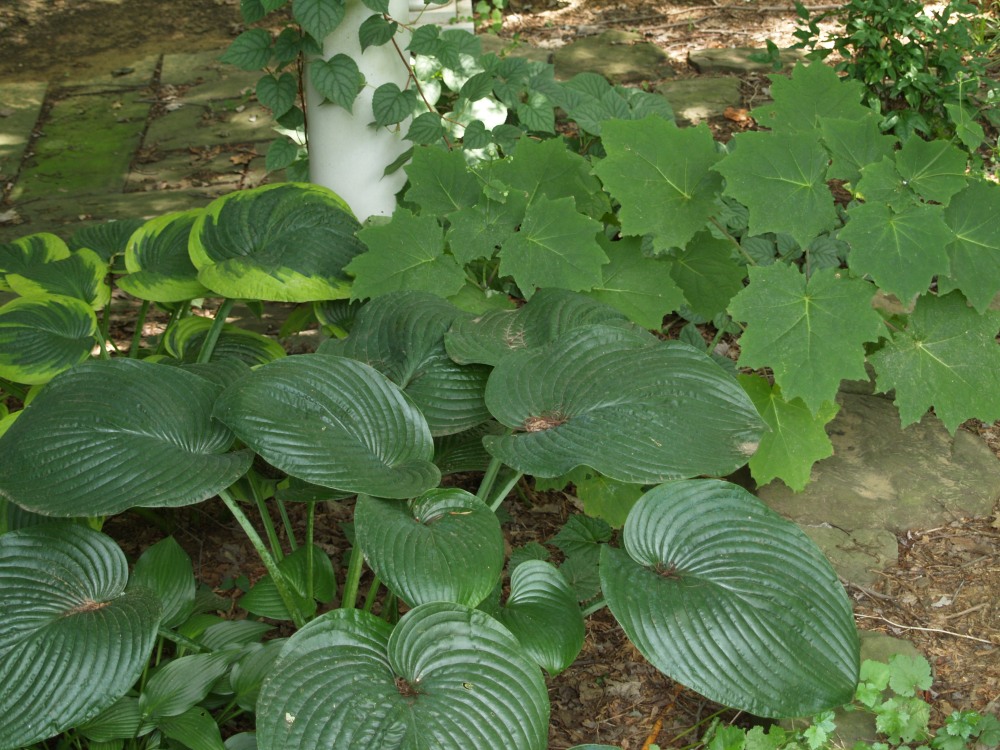No, not me, I’m big, but more bulldozer than beautiful, useful for digging holes and moving boulders. In my garden I’m a fool for any plant with large leaves, trees, shrubs, perennials, or tropicals, the bigger the better, I’ve got to have them. In garden design big leaves contrast nicely with just about any foliage in the garden, needled or broadleaf, but there’s probably some deeper psychological need that drives my fondness, and no doubt I have plenty of issues there.

Tropical elephant ears are the largest leaves in my garden, and I’ve steadily grown my collection of mostly colocasia and a few alocasia to a dozen or so varieties, and with offsets that I’ve harvested there are enough plants to fill half the basement when they’re brought in for the winter. The monster of the group is Colocasia gigantea (above), with leaves nearly five feet long, and if it was planted in more moist soil, and given a smidgen of fertilizer I’d have to find a new home for it with a lot more space. I saw a photo the other day where the gardener had pampered theirs, and the leaves looked to be closer to eight feet, so I’ve already planned for a nice damp spot for next year where it can grow without overwhelming everything in its path.

Most of the varieties of elephant ears are a bit smaller, some with green, black, or mottled colored leaves, but just about all have leaves a foot or more in length. I’ve planted them in large containers, in the ground, and in shallow water in the ponds, but all are brought in for the winter. The pots are hauled into the basement and clustered as close to the glass door as possible, and watered just enough to keep them alive. The light is barely adequate, and by mid-January they look pretty sad, but they’re alive and ready to go outdoors in late May.
The elephant ears planted in soil or water are dug up when the foliage dies down after early frosts, the dying leaves are cut off just above the roots, and the thick roots are left on the driveway for a few days to dry out. Once dry I throw them in a bag with dried, shredded leaves and stack the bags in a cooler, which is propped slightly open and put on a shelf against a heated wall in the unheated garage. Several varieties of tropical bananas and cannas (above) are overwintered the same way, and I’ll lose a few roots that rot because they weren’t dried completely, but I’ve found this to be quite easy and dependable, and it’s easier to convince the wife to give up the coolers for the winter than half the basement.
Bigleaf magnolia (Magnolia macrophylla, above) is quite cold hardy, but coarse in form, and it grows to be quite a monster, so it’s inappropriate for most gardens. I’ve managed a spot for it near the edge of the garden so that it spills over into the forest, and though it is tucked into a corner I often detour to marvel at its huge, two foot long leaves and late spring, fragrant blooms.
The largest of hosta leaves (above) are well over a foot wide, and varieties such as Sum and Substance and Big Daddy make a considerable clump after a few years, and tend to be more resistant to deer than others. I have planted so many in the garden that I’ve forgotten the names of most, but I enjoy them all, even as they flop over and block the garden paths.
Along the garden ponds and a long stream I’ve planted hostas, Japanese forest grass, and all manner of perennials that spill over the water’s edge, but also large leafed Darmera peltata (above) and Ligularias. On the dry slope behind the largest of the garden’s ponds Plume poppy (Macleaya cordata, below) has spread to fill the space between large evergreens. The large leaves give a tropical feel that is suited perfectly to the ponds.
Great writing, perhaps you should also be an author, that on top of everything else you do!
Pleased to hear that you get your hands dirty, a true gardener.
Some suggested reading, a book by Katherine S. White, wife of E. B. White who wrote Charlotte’s Web. Title: Onward and Upward in the Garden.
Thanks for your comment, and the book recommendation. I have a short attention span, so I’m not much of a book reader unless they’re broken into little pieces, which it appears this one is. While we’re discussing books I should get in a plug for my favorite author, Henry Mitchell, and the series of books that capture the best of his Essential Earthman articles that appeared in the Washington Post. I can’t imagine that there could be a better garden writer.